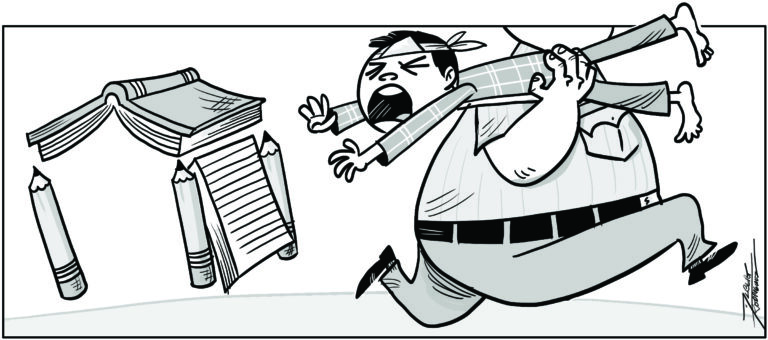
Philippine Daily Inquirer / February 20, 2021
Was it a rescue or a raid?
On Monday, police swooped down on the University of San Carlos (USC) in Talamban, Cebu, and forcibly took into custody at least 19 lumad students in what Central Visayas police chief Brig. Gen. Ronnie Montejo claimed was a “rescue operation.”
Montejo said the indigenous children “were taken by group members without their parents’ consent” and had not returned home since 2018. He added, without presenting proof, that the minors “underwent (communist) indoctrination and (were) asked to attend rallies (in Cebu City).”
In a statement, officials of the Society of the Divine Word, the congregation that supervises the USC, said the religious order had hosted the lumad students in March 2020 as part of their support for the bakwit, or evacuee, school program of the Cebu archdiocese. The students were supposed to return home after completing their modular schooling in April 2020, but the COVID-19 lockdown trapped them in the city. With the easing of quarantine restrictions, plans were made to return the IP (Indigenous People) minors to their homes, though this had to be done in batches because of considerable logistics needed for swab tests, transportation, and food allowances, said the statement signed by Fr. Rogelio Bag-ao, provincial head of the SVD Philippines Southern Province, and Fr. Narciso Cellan Jr., USC president. At least four minors had been sent home while another batch was scheduled to return this week. “Here, no rescue need ever be conducted because the presence of the lumad in the retreat house was for their welfare and well-being,” the priests stressed.
On Wednesday, the police filed charges of kidnapping and serious illegal detention—a nonbailable offense—in Davao del Norte against seven adults arrested in the raid.
Video taken during the incident casts serious doubts on the police narrative of a “rescue,” and the kidnapping and illegal detention charges they filed shortly after. Instead of welcoming their release as most kidnapped victims would, the IP minors were seen screaming, cowering in fear, and struggling against their “rescuers,” who had to bodily carry out some of them.
National Security Adviser Hermogenes Esperon insisted that the police operation was covered by a warrant, but did not—could not?—answer a reporter’s query on what complaint was indicated in the warrant and which court and judge had issued it.
The social welfare department itself, which was given custody of the IP minors, contradicted the official narrative. According to social welfare officer Annie Suico, based on her interviews with the children, there was no “child warrior training” as the police had alleged. “Sulat at basa lang ang tinuturo ng mga guardian nila,” Suico said, adding that the children were in good condition at the time of their “rescue.”
In a TV interview, police Lt. Col. Aurora Rayos, public information officer of Central Visayas’ PNP, claimed the police “rescue operation” was prompted by some parents’ report that their children had not come home for two years now. But why would these parents complain about their missing children only two years after the fact? And couldn’t the police have instead facilitated a reunion between parents and minors, with social workers and local officials mediating in case of conflict? Why resort to a violent “rescue” that would have traumatized the lumad minors further?
Then again, this incident is but the latest in the long history of harassment and violence directed at the lumad, even during previous administrations. Recall how, in 2015, North Cotabato Rep. Nancy Catamco spearheaded a similar “rescue” operation on displaced lumad camped in the Haran mission house of the United Church of Christ in the Philippines in Davao City, with anti-riot police, soldiers, and paramilitary men descending on the compound and rounding up the terrified evacuees. The operation was supposedly to “persuade” the lumad to return home after they fled military conflict in their land.
After his second State of the Nation Address in 2017, President Duterte threatened to bomb lumad schools for allegedly teaching “subversion” and “communism.” Later addressing lumad leaders, Mr. Duterte said he would personally choose the investors who would develop their ancestral domain to spur economic activity in the region. Following the administration’s bent, the Department of Education in 2019 closed down 55 lumad schools for alleged noncompliance with DepEd requirements. At least 178 lumad schools have been shut down since 2016, according to the Save Our Schools Network.
The lumad are driven from their lands, deprived of schools and livelihoods, targeted and brutalized even in the places where they have sought refuge. As lumad leader Datu Tungig Mansumuy-at lamented of the police and the military: “They don’t want us to study or have rights. They don’t want us to have our own lands. They want all of us to die.” Who can blame him and his people for such sentiments?